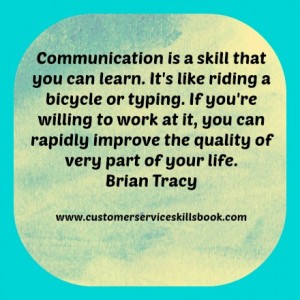Customer Service Representative – Active Listening Tips
Before you can effectively listen to your customers or clients as a customer service representative you must first prepare to listen. That is because active listening is a learned skill and is different from the passive action of simply hearing sounds. Not only do you need to take the opportunity to attend training sessions on how to become an active listener, but you must also focus your attention when listening and practice the skill on a regular basis in order to improve.
The following are some simple strategies you can use to increase the chances for a more positive interaction with your customers when talking to them face-to-face or over the telephone.
Eliminate physical barriers to effective communication. This means stop distracting actions. This includes using technology, taking notes (not related to the customer that you are serving), talking to others, or attending to other tasks.
Block mental barriers to communication. Many times you may have things going on in your brain that can cause you to not focus your complete attention on the person in front of you or on the telephone. Examples of this are biases against a person or group, preconceived ideas about what someone is saying or someone who reminds you of similar prior situations or people, anger, irritation, or physical and personal issues that distract from the job at hand. If you cannot appropriately attend to a customer or situation, excuse yourself and ask someone else to step in for you.
Focus on the customer and project a positive service attitude. Do this through your facial (e.g. smiling), non-verbal cues (e.g. posture and gestures) and verbal responses (e.g. tone, inflection, and pitch) while listening attentively to what they are saying.
Summarize your understanding frequently during a conversation. This is paraphrasing and involves repeating the customer’s message back to them in your own words. For example, once a customer has described why he or she came by or called, you might say something like, “So Mister Brown, if I understand you correctly, the issue is … Is that correct?” This approach lets the customer know that you were actually listening and helps ensure that you take the appropriate action or respond correctly. Just be careful to alternate your responses so that you do not use the same approach over several times. That would make you sound like a parrot and could actually irritate the customer.
Ask appropriate questions to clarify and get feedback from the customer. Closed-ended questions are good for affirmations that you understood something correctly or to get agreement or permission, but do little to involve your customer in a conversation. For example, “You would like to exchange this red scarf for one that has red in it but also has some more supple colors as well. Is that correct?” Closed-ended questions typically start with an action verb (e.g. do, did, can, should, or will) and normally lead to a short answer or yes/no response.
To engage your customers in more open dialogue, you might use open-ended questions. For example, “What would the perfect scarf look like to you Ms. Harrison?” This type of question allows the customer to take control of the conversation. It also can provide a subconscious feeling of empowerment, control, and decision-making. Such feelings can lead to less opportunity for dissatisfaction or change of mind later because the customer made the purchase decision and may not feel that you forced something on them that they did not want or like. Open-ended questions normally start with words like what, how, and why.
For more effective customer service tips, strategies and techniques for active listening, verbal and non-verbal communication with customers and other skills to help improve customer relationships, meet customer needs, wants and expectations and create a more customer-centric organization, get copies of How to Be a Great Call Center Representative, Please Every Customer: Delivering Stellar Customer Service Across Cultures and Customer Service Skills for Success. The latter book is the top-selling customer service textbook in the U.S.


